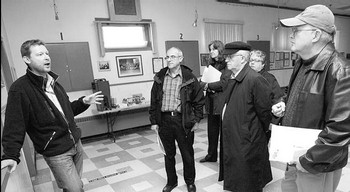Tar ponds cleanup moves closer to solidification, stabilization
By Debbie Gwynn
Cape Breton Post
Fri., May 16, 2008
Sydney - Before moving ahead with
the full scale solidification and stabilization
of the cooling pond project a
small field demonstration was carried
out in January 2008.
The Sydney Tar Ponds Agency held
an open house Thursday to update
residents of the Cape Breton Regional
Municipality with the results of the
testing.
The field demonstration, led by
Chris Holt, senior remediation engineer
with Earth Tech, helped engineers
to select which mix recipes
would work best on the cooling pond
sediment when the full-scale solidification
and stabilization technology is
applied.
Twelve cells were treated during
the testing. The total volume of contaminated
sediment treated was
about 1850m3 (enough sediment to
fill about 2,100 domestic oil tanks).
"This is pilot-scale work and is
needed before we can go ahead with
full scale solidification/stabilization,"
said Tanya Collier MacDonald, communications
officer for the tar ponds
agency, "where they (Earth Tech) show
their results meet the criteria regulators
have identified before moving
ahead with the full scale project."
Members of Sierra Club’s Cape Breton
Group issued a press release
Thursday demanding the results of
bench scale testing of the stabilization
and solidification of the Sydney
tar ponds sludge completed in May
2007, be released to the public immediately.
"This technology holds no promise
of success with tar ponds sludge,"
said Dan McMullin, chair of Sierra
Club’s Cape Breton Group in the
release. "Once again, government will
squander hundreds of millions on a
proposal that may well make matters
worse."
Reports from the testing carried
out in 2007 along with results from
the pilot-scale work will be sent to the
regulators, Nova Scotia Environment
and Public Works and Government
Services Canada upon completion.
Collier MacDonald anticipates it
will be four to six months before all
results are in, the regulators approve
it and the agency can move forward.
"We will release the results of the
reports of the bench-scale and pilotscale
work at that time," said Collier
MacDonald.
Although exact figures were not
available, Collier MacDonald believes
that during peak construction periods
approximately 120 people will be
involved on the construction side of
the project — but added the numbers
will fluctuate.
Upon approval, full-scale stabilization
and solidification of the Sydney
tar ponds is expected to be completed
by 2014.
dgwynn@cbpost.com

Chris Holt (left), design engineer with Earth Tech, fields questions from concerned citizens on the proposed plan of solidification and
stabilization of the Sydney tar ponds. The group gathered at a Sydney Tar Ponds Agency open house at the Royal Canadian Legion
Branch 12 in Sydney, Thursday. From right, chair of the Sierra Club of Cape Breton Group Dan McMullin, former Frederick Street resident
Debbie Ouellette, Aubrey Rodgers, Marlene Kane and Richard Barrington. Steve Wadden - Cape Breton Post
Measurements
The pre-selected performance criteria
included the measuring of the following
characteristics:
- Strength - results were typically 3-4
times greater than specified criteria.
- Permeability (the ability for water to
pass through the treated sediment) -
results confirmed that the treated
sediment was impermeable and surpassed
all criteria requirements.
- Leachate (the ability for contaminants
to be released from the treated
sediment)- results easily
achieved adopted criteria.
|